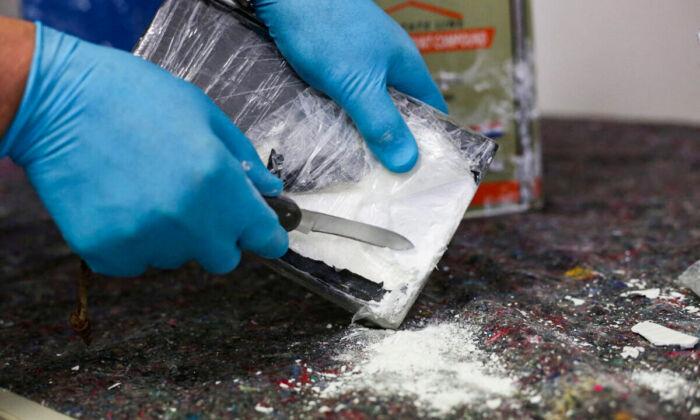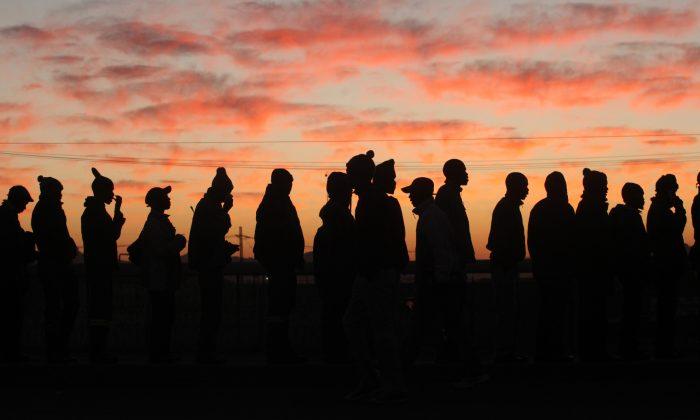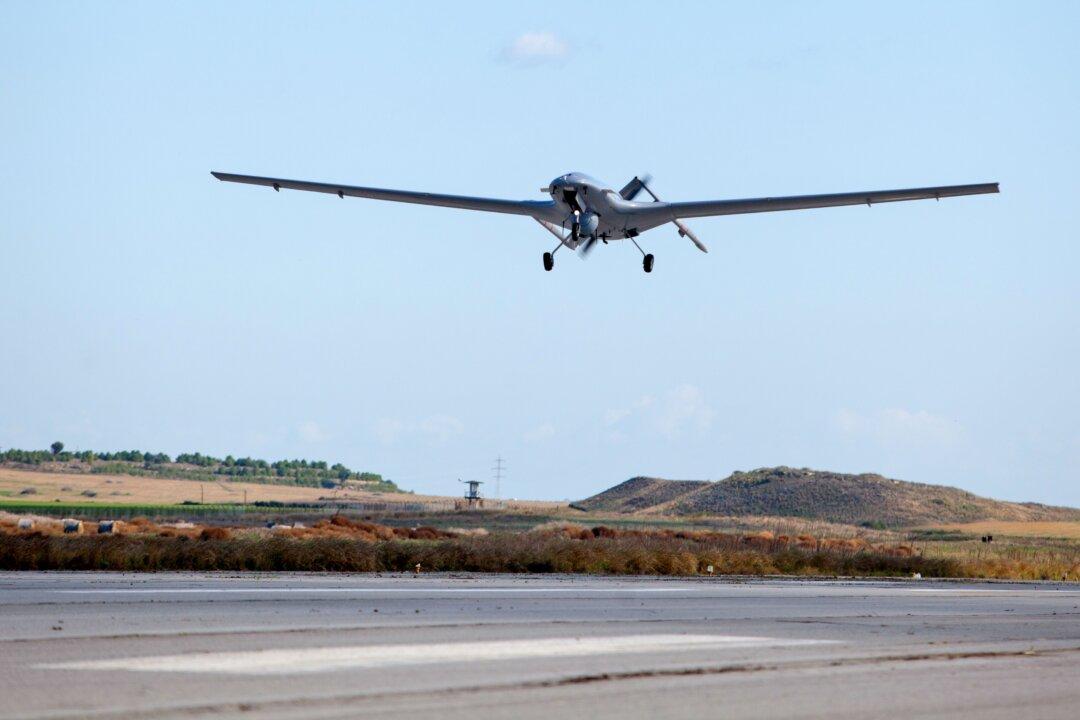JOHANNESBURG—The globe’s biggest narcotraffickers are increasingly using South African ports to smuggle cocaine around the world—including to the United States—according to a new report by the U.N. Office on Drugs and Crime.
Investigators from South Africa’s special crime-busting unit, the Hawks, which targets organized crime, confirmed the report’s contents to The Epoch Times, saying that “record amounts” of cocaine have been seized since the end of the COVID-19 pandemic.
On Feb. 23, authorities at the port of Durban—on the country’s east coast—discovered almost 900 pounds of cocaine in a container aboard a ship.

The same day, Brazil’s finance ministry announced that police had swooped in to seize a container destined for Durban at the port of Paranaguá, Brazil.
“The cocaine was hidden in the container’s refrigerated engine, which was loaded with 27 tons of chicken gizzards,” the ministry said in a statement.
“The preliminary investigation indicates that the drug was introduced into the container without the knowledge of either the exporter or the importer.”
The U.N. report pointed to Durban, one of the most developed and busiest ports in Africa, as a major hub of cocaine trafficking.
“Seizure data suggest that cocaine flows into South Africa have increased significantly in recent years, and a majority of this is likely further trafficked to other countries, consolidating South Africa’s long-standing role as a transit country, as confirmed by South African authorities,” it states.
The report noted that the majority of cocaine shipments were entering South Africa from South America, with the narcotics destined for countries including Australia, the United Kingdom, and Hong Kong.
“From June 2021, when COVID started easing off and the world started opening up until now we are finding tons of cocaine, especially in Durban,” Col. Katlego Mogale of the Hawks said.
“Our first big bust was 541 kilograms [1193 pounds], worth about 220 million rands (about $13 million). The cocaine was in canvas bags placed amongst a legitimate shipment of animal food,” the Hawks spokesperson told The Epoch Times.

Two months later, the Hawks seized more than a ton of cocaine that had been concealed in a container of truck engines sent to Durban harbor from Brazil.
A senior police source told The Epoch Times that South American narcotraffickers had established links with crime cartels based in South Africa to “exploit weaknesses” at the country’s ports.
“Together, the organized crime groups recruit workers and officials at the harbors, and they all collude to circumvent checks and to get the cocaine into containers and onboard ships,” he said.
The officer identified the Brazilian ports of Paranaguá and Santos as key points where cocaine from several South American countries was leaving “by the ton,” mostly destined for Durban.
Global anticrime agency Interpol has said that one of Brazil’s and the world’s most powerful organized crime groups, the Primeiro Comando da Capital, or First Capital Command, is at the center of South American narcotics trafficking.
Hawks investigators said several “big loads of cocaine” intercepted by Brazilian authorities at Paranaguá and Santos since 2021 had been destined for South Africa.

Brazil’s Federal Police launched two operations in February 2022 to try to crack organized crime syndicates smuggling cocaine to Europe from South America.
They announced that Brazilian gangs, primarily Primeiro, were colluding with the Italian mafia group ‘Ndrangheta.
Hawks investigators said South African crime groups had forged links with global counterparts, including Italian and Eastern European mafia groups, since the 1990s, when the African National Congress (ANC) replaced the apartheid National Party in government.
South Africa’s descent into crime since the multiparty democracy in 1994 is well-documented; it now has some of the highest violent crime rates in the world.
“There are many South African gangs focused on drugs and only drugs,“ Johan Burger, a former South African police colonel and resident crime expert at the Institute for Security Studies in Pretoria, told The Epoch Times. ”COVID-19 and all the lockdowns have provided [the] impetus to mafia-type organizations to use sea transport more for their contraband.
“During COVID almost all air transport stopped, while the ports became clogged with containers that had to be processed, fast, so that the huge backlogs could be cleared to get back to normalcy.
‘Wonderful Location for Traffickers’
Burger said South Africa, with its well-developed and technologically advanced harbors—when compared with the rest of Africa—is also “very strategically positioned at the southern tip of the continent on routes offering access to South and North America, as well as to Asia and Australasia.”“It’s a wonderful location for traffickers,” he said.
Add to that a high level of official corruption, Burger said, “and the incentive to use South Africa as a major drug transit point becomes very high.”
He said South African investigations had recently focused on vessels belonging to the Mediterranean Shipping Co. (MSC). In November 2021, the Hawks seized cocaine it said was worth about 240 million rands (about $14 million) on an MSC ship in Durban.
“The team received information about the MSC vessel that was sailing from South America to South Africa transporting containers with wooden flooring boards [beneath] which cocaine had [been] concealed within the consignment,” a Hawks statement at the time read.
MSC officials told The Epoch Times the company spent about $100 million on “cargo security upgrades” in 2022 and that it was doing all it could to detect, prevent, and disrupt drug trafficking from using its containers.
$1 Billion of Cocaine on MSC Vessel
In June 2019, U.S. authorities made one of the biggest interceptions of cocaine in the nation’s history, when they found cocaine worth more than $1 billion on a ship belonging to MSC at the port of Philadelphia.Two crew members from Montenegro were eventually jailed for 6 1/2 and 7 years, respectively, for conspiracy to smuggle narcotics into the United States.
Then, in October last year, a former heavyweight boxer from Montenegro, Goran Gogic, was arrested in Miami for his alleged role in the crime.
A U.S. government detention memorandum against Gogic said the trafficking syndicate he allegedly was part of would hoist loads of cocaine from speedboats onto commercial cargo ships at night off the coasts of Colombia, Ecuador, and Peru.
“To physically load the cocaine aboard, they used the ship’s cranes as well as nets. Once the cocaine was on board, the crew members would secrete it within specific shipping containers that they knew had room to conceal the large quantities of cocaine they were trafficking and for which they had duplicate counterfeit container seals,” reads the memorandum.
Links to Balkans
The U.S. detention document relating to Gogic’s case alleged he was part of a “vast international narcotrafficking conspiracy responsible for transporting multi-ton loads of cocaine” into countries including South Africa.It claimed Gogic and his co-conspirators “used commercial container maritime vessels that transited from South America to the United States to Europe to transport cocaine for cartels in the Balkans.”
The Global Initiative Against Transnational Organized Crime (GI-TOC) said South Africa became a haven for Balkan criminals, “especially Serbs,” during and after the Balkan conflicts of the 1990s.
Like many other mafia-type organizations, Balkan criminals viewed South Africa as an excellent base because it was developed in terms of communications and banking, it was “far away from European justice,” and its government and law enforcement authorities were considered “easily corruptible,” said Fatjona Mejdina, director of GI-TOC operations in southeastern Europe.
Pretoria also doesn’t have extradition agreements with any of the major Balkan states.
South Africa’s association with Eastern European criminals stretches back to the early 1990s, a period of social upheaval in a country that was transitioning to multiparty democracy from apartheid.
“There are a lot of these guys here,” a senior South African police intelligence officer told The Epoch Times.
“It’s easy for them to come to our country because they present themselves as legitimate businessmen with lots of money to invest.
“All their papers appear legal, even though they use numerous identities when they live here. They set up front companies and they start moving cocaine, big time.”
He described the Serbians, in particular, as “hardened criminals.”
“Some of them fought in the war of the 1990s; some of them came here to avoid fighting in the war. But all know what they are doing, especially when it comes to cocaine,” he said.
Drug Killings in South Africa
The officer identified two “major Serbia–Montenegro mafia groups” currently operating across South Africa, in cooperation with local gangs.“The two sometimes have a disagreement, and that’s when you see these assassinations,” he said.
In recent years, several Serbian nationals have been shot dead in apparent hits in Cape Town and Johannesburg.
According to the Crime and Corruption Reporting Network (KRIK), a Serbian monitoring group, criminals from Balkan countries have been able to build strong alliances in South Africa’s underworld, and with “influential” figures in local circles, including politicians and high-ranking law enforcement officials.
It named Serbian cocaine kingpin Darko Saric as one who fled to South Africa in 2010.
In an affidavit, he said he’d lived in Johannesburg, “under the protection of local mafia and police.”
Saric was tracked to Brazil in 2014 and taken into custody in a joint operation by local police and the Serbian and Montenegrin secret service. In 2018, he was sentenced to 15 years in prison for drug trafficking. In 2020, he received another nine years after being found guilty of money laundering.
During the trial of former Czech organized crime boss Radovan Krejcir in Johannesburg in 2016, it emerged that he’d surrounded himself with Serbian “helpers” and “bodyguards” who he sometimes used as “enforcers.”
He fled to South Africa in 2013, after prosecution authorities charged him in connection with his alleged organized crime activities in the Czech Republic.
Krejcir wasted no time in resuming crime in his adoptive homeland and is currently serving a 35-year sentence for a list of offenses committed in South Africa, including attempted murder, assault, and kidnapping.
KRIK said South Africa was, and remained, a chosen destination for “older criminals” who operated in Serbia in the 1990s and early 2000s.
South African private and state security operatives investigating organized crime groups in the country confirmed KRIK’s findings to The Epoch Times.
One said South Africa remained a “battleground” for Eastern European “drug-runners” who were “very active in the 1990s” but had “seen new horizons” in a democratic South Africa that they considered as being “pretty much lawless.”
He recalled the killing of Serbian mobster Darko Kulic, who was gunned down in his luxury vehicle in rush-hour traffic in Johannesburg in 2018.
“These guys we see being assassinated from about 2015 until now are all basically carbon copies. They’re all involved in moving vast quantities of [cocaine], and most fought in the [Balkan] wars of the early 1990s.”
KRIK said Kulic had been a member of the paramilitary group‚ the Serbian Guard‚ during the Yugoslavian civil war.
Kulic’s murder happened six weeks after the killing of fellow Serbian national Milan “Miki” Djuricic, who also died in a hail of bullets fired from a high-velocity automatic rifle in the same suburb where the Kulic shooting took place.
At the time, Djuricic was wanted for the 2000 killing of Serbian warlord Zeljko “Arkan” Razatovic in 2000.
“Cocaine is the link in all of this,” the security operative said. “Their war is now cocaine. Serbians are central figures in [the] European cocaine trade.
“They traffic the coke from South America to South Africa. From here, it goes to various destinations, like Turkey. From there, it enters Europe.”
Burger said South Africa now is a “very firm and very important bridge” linking worldwide cocaine markets.



